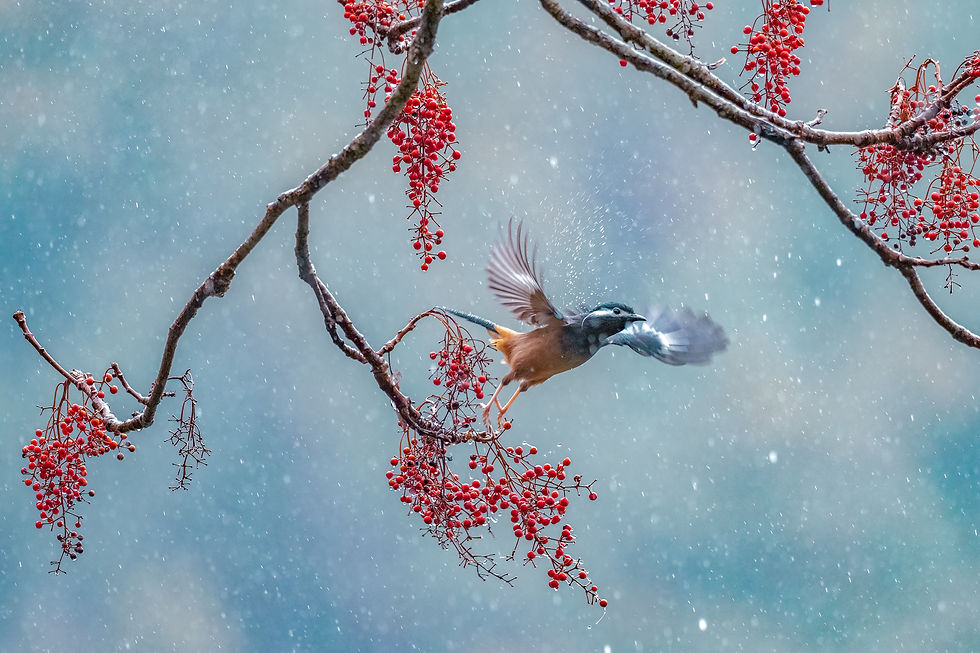How Animals Handle the Weather
- Sam Nunes
- Aug 12, 2023
- 3 min read

Have you ever wondered how animals weather storms? They are outdoors all the time and depending on where they are in the world, they need to be prepared to handle the high and low temperatures as well as heavy rain and wind. But animals are not completely helpless when it comes to handling the weather. When nature presents challenges, life needs to find a way to adapt. So how do animals handle the weather? Let’s get into it!

Sometimes it can be very hot, and animals don’t have fans and air conditioners to cool down. Some animals sweat, like humans, which cools down the body as the moisture absorbs heat from the air to evaporate, creating a cooling sensation. In fact, the reason humid days feel so uncomfortable is because the air is too saturated to allow for the sweat to evaporate so we just feel hot and wet. Other animals pant, like dogs and birds. This way of expelling heat is done by getting rid of the heat in our bodies through their breath. Another cool way some animals deal with the heat is with their ears. Animals with big ears like the elephant and the rabbit, use their big thin ears as a means to expel heat by sending warm blood to the edges of the skin in their ears to release their heat and cool off before reentering the body and in turn cooling the body.
Interestingly, these areas that radiate heat away from the body have been growing in many animal species in response to a warming climate. Chinese roundleaf bats have bigger wings, European Rabbits have larger ears, mice have bigger tails, and birds have bigger beaks. This can be seen from the comparison of these animals today with museum records dating back to the 1800s. This increase in surface area in these thinner areas of the animals bodies allow them to radiate more heat and cool their bodies better in a warmer climate.

Coincidentally, increase in size has also benefited animals that need to handle cold environments as well but in a different way. In this case, an increased volume to surface area makes an animal better able to retain heat. This means that animals in colder climates increase their volumes or how much space they take up, without changing to the same ratio the amount of skin that is in contact with the air. A good example of this are the seagulls you find down in the tropics are much smaller than the seagulls you’ll find in northern latitudes like Canada, or the British Isles. So in cold, thick bodies retain heat better and in hot, thin bodies or thin parts of the bodies radiate heat away.
But it's not just hot and cold that animals have to deal with. The weather is always dynamically changing as high and low pressure systems glide across the earth and collide with impressive displays of rain and wind. But animals are equipped to handle this too. As I mentioned, part of what creates weather events like rain and wind are the changes in air pressure. Most humans can’t detect this without equipment, with the exception of many with impressive awareness and knowledge of how the pressure impacts their bodies.

Along with them, birds are also able to detect these changes in barometric pressure and take shelter before a storm arrives. It makes them reliable messengers of a storm’s arrival. The air pressure also influences the oceans, and many bony fish and sharks with complex biological pressure gauge systems in their bodies like the lateral line are able to detect these changes and retreat to deeper water.

Wind is a particular challenge that affects many animals including marine animals. But perching birds like song birds can handle winds better than other animals because their feet naturally tighten around a perch when at rest. This allows them to stay perched even when they are sleeping. Woodpeckers and other birds that nest in cavities will stay there to ride out the storm, and shorebirds also move inland as well. Most of the bird’s success in handling wind is dependent on how well the trees handle the wind.
The animals that live outdoors need to constantly be prepared for the many different variations of weather that can impact their survival. Animals have evolved with many tools to handle these changes as the climate has changed and they are still evolving today. Some animals need to release heat, some need to conserve heat, and some animals need to be able to predict upcoming storms in time to find shelter. As always, when challenges arise, nature finds a solution.
Heat -
Cold -
Rain -
Wind -







Comments